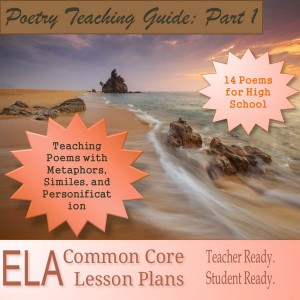Before we study poems with metaphors, let’s take a look at what it means to master metaphors. And let’s take a look at how studying poems with metaphors can help you improve your ability to communicate.
Here’s a lesson plan: Examples of Figurative Language in Poetry
Master Metaphors

There’ll be no more stammering through 45 minutes of discussing a poem that takes 2 minutes to read. The Poetry Part 1 teaching guide includes a summary and analysis of 14 poems; a ready-to-annotate and analyze copy of each poem; graphic organizers for digging deeper into metaphors, similes, personification, imagery, and theme; a guide for annotating and analyzing a poem; and answer keys for everything.
It’s all bundled into one nice pdf. All you need to do is make copies and do what you do.
Make sure that what you learn is valuable beyond the walls of the classroom. As you study examples of metaphors in poetry, focus on the lasting benefits of becoming a metaphor master. Use the following guidelines.
- You should know what a metaphor is if you are studying examples of metaphors in poetry. Simply knowing the definition, however, is not sufficient.
- You should be able to identify examples of metaphors in poetry on your own.
- You should be able to explain the purpose for the metaphor and analyze how it contributes to the theme of the poem. I have provided analysis with my examples to show you what I mean.
- You should be able to write poems containing a metaphor.
- You should be able to use metaphors in your own writing to communicate more clearly.
- Once you are able to own metaphors and use them to promote your ideas clearly, you will have become a metaphor master. Let’s begin by analyzing the following poem.
Sympathy by Paul Laurence Dunbar

Imagine having 11 complete poetry units with handouts and lesson plans completed. You don’t need to imagine. These units are teacher ready and student ready. Just print, make copies, and accept accolades from colleagues and students.
I know why the caged bird sings, ah me,
Metaphor: I know why the caged bird beats his wing / Till its blood is red on the cruel bars; / For he must fly back to his perch and cling / When he fain would be on the bough a-swing; / And a pain still throbs in the old, old scars / And they pulse again with a keener sting– / I know why he beats his wing!
Analysis: Dunbar uses a metaphor comparing a caged bird beating its wings against its cage until they bleed to his own struggle against oppression. The bird’s physical scars metaphorically refer to the mental scars of oppression. The phrase old, old scars may represent the entrenched racism that had existed in the United States since its founding.
